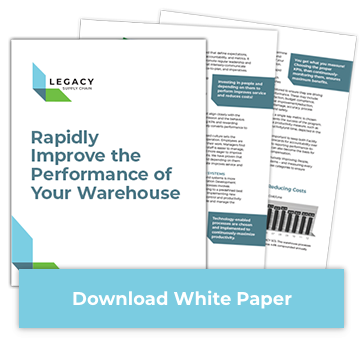Warehouse Optimization: The Problem With Having No Problems

How Speaking Up Can Boost Warehouse Optimization
There’s a story told about a Toyota executive who, while touring a plant, asked about the problems that factory faced. When he was told there were no problems, he noted that if there were no problems, there was no need for a manager. This oft-repeated story is a great way to illustrate a key management lesson that is especially applicable in warehouse optimization: if no problems are being reported, then no improvements of efficiency are being made.
Warehouse optimization is all about continually improving efficiency. A turnback is anything that causes a deviation from the established system. At LEGACY, we measure ourselves in performance improvements. In order to address any inefficiencies, we recommend you tackle them in three parts:
- Turnback Collection: Identifying problems or inefficiencies that exist
- Turnback Response: Addressing and fixing the problems so they don’t happen again
- Implementing Change: Learning from your experience by implementing sustainable
improvements
Warehouse Optimization: Turnback Collection
Start with the Leadership
Managers should be constantly on the lookout for turnbacks. While the workers in the warehouse are usually the ones best suited to notice an immediate problem, it is the manager’s job to be vigilant in finding these problems.
Workers Speaking Up
Let’s take a look at a common turnback in a typical warehouse: While a worker is packing a box, they notice there is an item missing, and they leave their station to locate it. Since this search is a deviation from the established process, this would be considered a turnback. A vigilant manager would notice this deviation and ask what had caused the turnback, but ideally, the worker would report the missing item before starting his or her own search for it.
LEGACY Core Value: INTEGRITY
If you see that something is not being done right, have the integrity to say something and report it.
It makes it a better process and place for everyone.
Methodology
There are many methodologies in collection turnbacks.
- Andon is a system of signals or lights that indicate when something has gone wrong, and needs to be addressed. Depending on your warehouse setup and size, this might be an effective way to flag and address problems, especially if a single warehouse manager is responsible for overseeing a large number of workers.
- 5S methodology is an organization method that many Lean manufacturing and other warehouses use to organize their workspace for maximum efficiency: Sort, Straighten (or Streamline), Shine, Standardize, and Sustain. It’s easy to incorporate a reporting methodology into the 2nd “S,” Straighten/Streamline, and the remedy/response portion would fall under the 4th “S,” Standardize.
- White Boards: Sometimes it works best to keep your warehouse optimization methodology as simple as possible, especially at the beginning. Some of our Supply Chain Engineering client warehouses have found white boards to be a very effective, straightforward way to visually track problems (turnbacks) reported, and their progress. Seeing turnbacks on the white board reminds employees to reports problems they find.
Warehouse Optimization: Turnback Response
Reporting Encouraged
When workers do report these problems, it’s very important to encourage the behavior by recognizing the integrity demonstrated, and acting quickly and proactively to manage and resolve the problem causing the turnback. The very act of solving the problem and implementing a change as a part of your warehouse optimization process acts as a positive reinforcement of problem-reporting behavior, in that the changes result in tangible improvements. Conversely, the inverse reinforcement is true when nothing is reported—the lack of change perpetuates a culture of shrugging off inefficiencies by indicating the feeling that “it won’t matter.”
Culture of Support
It’s easy enough to implement a rule that problems should be reported—it’s another thing altogether to create and maintain a culture in which speaking up about inefficiencies is accepted and encouraged. Many workplaces may say that they’d like to know about inefficiencies, but may in effect punish workers who bring turnbacks to their attention by ignoring them or even blaming them for the problem.
Learn How LEGACY SCS Can Help Solve Your Dynamic Warehouse Distribution and Labor Challenges >
Culture of Flexibility
The culture of the warehouse also has to be flexible enough that reporting a problem is not only acceptable and encouraged, but is also a process that is realistic and solvable during the course of a typical day. If a warehouse prioritizes completing quotas above all else, workers will take a system into their own hands to complete their quotas at all costs, instead of being able to build an optimized warehouse through teamwork, making the most efficient system for the long run.
LEGACY Core Value: BEING THE BEST
We are committed to getting as much waste as possible out of a warehouse or logistics system. This means looking beyond each package to the long term: things can always be improved, always be better. And we are committed to creating a warehouse where that is possible by encouraging and leaving room for turnback collections.
Identifying the Problem
Once a turnback is reported, it’s important to analyze the problem and discover its source. Why is this happening? Is it a substandard ID system? Is there a discrepancy in the order forms, or human error? Is there lack of oversight during picking? Once the problem is identified, the solutions can be formulated that can change future outcomes. You can download a case study example of how LEGACY helped a Fortune 100 Energy Provider with warehouse optimization through Lean practices here.
Warehouse Optimization: Implementing Change
There is an obvious and fundamental difference between warehouse operations that talk about Lean on a project or function level, and a company like LEGACY, where improving processes is part of our culture.
In a true Lean warehouse, reporting problems is seen as a good thing — an opportunity for improvement and an important part of warehouse optimization.
Many companies talk about Lean practices in terms of standalone functions like reducing head count, cutting costs, etc., and the results are clear: dissatisfied customers. There’s a difference between lip service and a true cultural commitment to continuous improvement.
It all starts with turnback collections — reporting problems. If you’re told your warehouse has no problems, the inability to see them IS the problem. LEGACY understands how to optimize warehouses for better customer service, happier clients, and more productive workers. We help you identify problems, respond to them and implement change for continuous improvement — Improve, Grow, Protect.
Get Insights. Stay Ahead.
Get the latest news and insights via email on warehouse improvement, transportation optimization, labor strikes and international shipping rate changes.Popular Posts
Search Posts
-
2024 Q1 Freight Landscape: Trends, Challenges, and Predictions
As the first quarter of 2024 comes to an end, here are some observations over the past few months as well as predictions about the trucking...
+ Read more -
Baltimore Bridge Impact Assessment – Update
Following the recent Baltimore Bridge collapse and subsequent port closures, we want to keep our customers informed about the situation and...
+ Read more -
Global Momentum Builds for Charge on Global Shipping Sector’s CO2 Emissions
A growing coalition of 47 countries, including key players like the European Union, Canada, Japan, and various Pacific Island nations, is...
+ Read more










